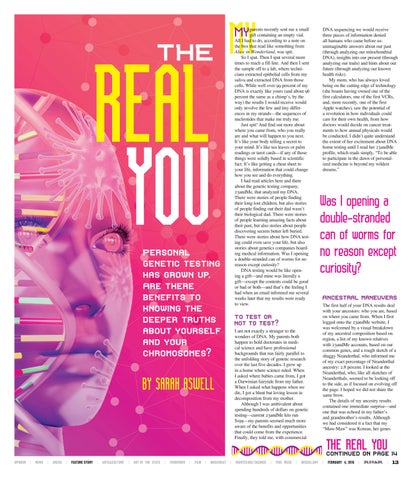My
parents recently sent me a small gift containing an empty vial. All I had to do, according to a note on the box that read like something from Alice in Wonderland, was spit. So I spat. Then I spat several more times to reach a fill line. And then I sent the sample off to a lab, where technicians extracted epithelial cells from my saliva and extracted DNA from those cells. While well over 99 percent of my DNA is exactly like yours (and about 96 percent the same as a chimp’s, by the way) the results I would receive would only involve the few and tiny differences in my strands—the sequences of nucleotides that make me truly me. Just spit! And find out more about where you came from, who you really are and what will happen to you next. It’s like your body telling a secret to your mind. It’s like tea leaves or palm readings or tarot cards—if any of those things were solidly based in scientific fact. It’s like getting a cheat sheet to your life, information that could change how you see and do everything. I had read articles here and there about the genetic testing company, 23andMe, that analyzed my DNA. There were stories of people finding their long-lost children, but also stories of people finding out their dad wasn’t their biological dad. There were stories of people learning amazing facts about their past, but also stories about people discovering secrets better left buried. There were stories about how DNA testing could even save your life, but also stories about genetics companies hoarding medical information. Was I opening a double-stranded can of worms for no reason except curiosity? DNA testing would be like opening a gift—and mine was literally a gift—except the contents could be good or bad or both—and that’s the feeling I had when an email informed me several weeks later that my results were ready to view.
THE
REAL YOU
Personal genetic testing has grown up. Are there benefits to knowing the deeper truths about yourself and your chromosomes?
To test or not to test? I am not exactly a stranger to the wonders of DNA. My parents both happen to hold doctorates in medical science and have professional backgrounds that run fairly parallel to the unfolding story of genetic research over the last five decades. I grew up in a home where science ruled. When I asked where babies came from, I got a Darwinian fairytale from my father. When I asked what happens when we die, I got a blunt but loving lesson in decomposition from my mother. Although I was ambivalent about spending hundreds of dollars on genetic testing—current 23andMe kits run $199—my parents seemed much more aware of the benefits and opportunities that could come from the experience. Finally, they told me, with commercial
BY SARAH ASWELL
DNA sequencing we would receive three pieces of information denied all humans who came before us: unimaginable answers about our past (through analyzing our mitochondrial DNA), insights into our present (through analyzing our traits) and hints about our future (through analyzing our known health risks). My mom, who has always loved being on the cutting edge of technology (she boasts having owned one of the first calculators, one of the first VCRs, and, more recently, one of the first Apple watches), saw the potential of a revolution in how individuals could care for their own health, from how doctors would decide on cancer treatments to how annual physicals would be conducted. I didn’t quite understand the extent of her excitement about DNA home testing until I read her 23andMe profile, which reads simply, “To be able to participate in the dawn of personalized medicine is beyond my wildest dreams.”
Was I opening a double-stranded can of worms for no reason except curiosity? Ancestral maneuvers The first half of your DNA results deal with your ancestors: who you are, based on where you came from. When I first logged onto the 23andMe website, I was welcomed by a visual breakdown of my ancestral composition based on region, a list of my known relatives with 23andMe accounts, based on our common genes, and a rough sketch of a shaggy Neanderthal, who informed me of my exact percentage of Neanderthal ancestry: 2.8 percent. I looked at the Neanderthal, who, like all sketches of Neanderthals, seemed to be looking off to the side, as if focused on evolving off the page. I hoped we did not share the same brow. The details of my ancestry results contained one immediate surprise—and one that was echoed in my father’s and grandmother’s results. Although we had considered it a fact that my “Maw-Maw” was Korean, her genes
THE REAL YOU
continued on page 14 OPINION
|
NEWS
|
GREEN
|
FEATURE STORY
|
ARTS&CULTURE
|
ART OF THE STATE
|
FOODFINDS
|
FILM
|
MUSICBEAT
|
NIGHTCLUBS/CASINOS
|
THIS WEEK
|
MISCELLANY
|
FEBRUARY 4, 2016
|
RN&R
|
13











